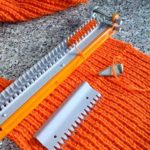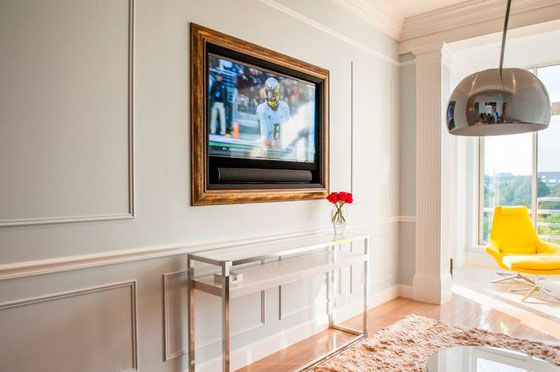How to connect an antenna to a TV
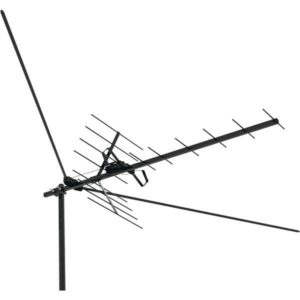 Almost everyone, at least once, while watching TV, has been annoyed by a bad picture or lack of one at all. The quality of the antenna and the correctness of its connection are as important as the quality of the TV itself, which becomes useless without a TV signal.
Almost everyone, at least once, while watching TV, has been annoyed by a bad picture or lack of one at all. The quality of the antenna and the correctness of its connection are as important as the quality of the TV itself, which becomes useless without a TV signal.
The content of the article
What types of television antennas are there?
All television receivers that do not receive a signal via cable television are connected to an antenna. Depending on the distance from the broadcasting tower, devices for receiving the signal are divided into indoor, low-power (if the tower is close) and outdoor. It is worth mentioning separately about satellite ones - they take the signal not from a relay tower, but from a satellite.
Indoor antennas
This type is installed indoors. Ease of installation and low cost are the advantages of these devices. There is no need to install a rod, drill holes in the walls for the input of coaxial cable and lay it.
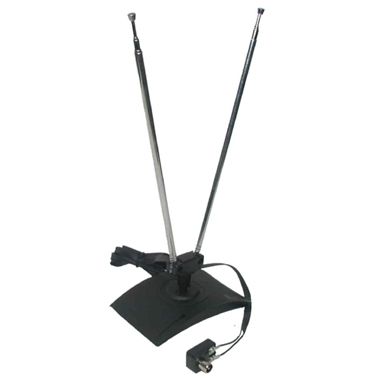
ATTENTION! Indoor antennas are capable of receiving only a very strong signal; they are installed no further than 30 km from the television center, and only if the walls of the house are sufficiently permeable to radio waves.
In turn, they are divided into frame and rod.
- Rod ones - “horns”, “rabbit ears” - have from two to four pins, often retractable. These are the weakest signal receiving devices. Among the advantages are lightness, compactness, ease of transportation. It works quite well only in the meter range, at its very bottom. To adjust, change the position of the antenna, orientation in space, length and angle between the “horns” - the mustache. It often happens that after tuning into one channel, another will show poorly.
- Frame. For the UHF range, more advanced frame ones are designed, in the form of a closed loop on a stand. Reception quality is slightly higher.
Outdoor antennas
The most common type, it has many solutions and modifications. To avoid signal distortion, the antenna is placed as high as possible - there are recommendations for installation at a height of 10–15 meters, and in multi-storey buildings, as a rule, it is placed on the roof. They are divided into active and passive:
- Active. They are equipped with an amplifier placed directly on the structure in a sealed housing, which has an independent power source (usually 12 V). Can receive very weak or distorted signals beyond line of sight. Through splitters they can distribute a signal to several TVs.
- Passive. They are used when there is direct visibility of the transmitter, especially when located close to it - sometimes the signal, on the contrary, is too strong and is also distorted. In these cases, an attenuator is used - a reducing device. Naturally, passive devices are cheaper than active ones.
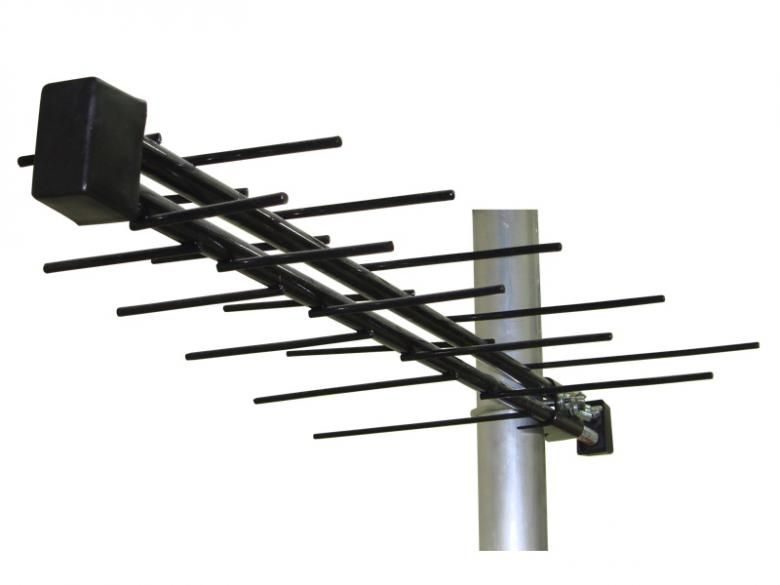
Satellite dishes
This is the best device for TV reception. Due to the massive structure, its price is an order of magnitude more expensive than other options. This is a concave dish painted white, aimed at the satellite.Signals from the satellite, falling on a concave surface, are reflected and concentrated at the point where the converter is located - the receiver itself. On one “dish” you can put several converters, one for each satellite.
The satellite signal is completely different from analog TV, so you will also need a receiver - a device for searching and switching channels and the satellites themselves, which converts the signal into a “understandable” one for the TV. Satellite broadcasting is sometimes the only solution for television reception in remote or rugged areas - the picture is almost always perfect, only a thunderstorm or heavy snowfall can cause interference.
In addition to the advantages, “plates” also have disadvantages. This is the cost, complexity of installation and configuration (only a professional can position the structure correctly and configure the receiver). Diagnosing the correct position requires special equipment.

ATTENTION! The wind may move the antenna, thereby disrupting the direction, or nearby trees will block the visibility of the satellite - maintenance measures will be required.
It will also not be possible to distribute different channels from a “dish” to several TVs, since both the receiver and the converter operate only with one frequency.
How to connect different types of antennas to your TV
The method of connecting an antenna to a TV directly depends on its type. Satellite is the most difficult to connect, followed by outdoor ones, and indoor ones are the easiest to connect.
Features of connecting a satellite dish
A satellite TV system consists of the following components:
- the antenna itself;
- receiver;
- tuning cable;
- converter
The first step is to install the “plate” itself on an adjustable mount.Experts calculate for each area the direction in which the satellite is located and the angle of inclination of the antenna, determined by its height. The connector is not tightened too much, since a special adjustment cable will be used, which will then be replaced with a permanent one.

Then the receiver is prepared. It needs to be flashed to work with a specific satellite, and a list of channels must be “uploaded” into it. In the future, if the number of channels steadily decreases, this procedure must be repeated. The receiver is connected to the TV via an AV cable (“tulip”) or HDMI.
It is also possible to connect to a regular antenna socket - receivers have a built-in modulator, but the quality with this connection is significantly reduced. The TV is configured to work with this type of connection, and the position of the antenna and the converter on it begins to be adjusted to achieve optimal signal strength. The receiver displays it digitally, but in some cases special devices may be required. After tuning, change the tuning cable to a permanent one.
How to connect an indoor antenna
When connecting both indoor and indoor antennas, you first need to decide what type of connector your TV requires - a modern F or an outdated round one with a hole in the middle. The signal is transmitted between the antenna and the TV via an RF coaxial cable. After connecting the device to the TV, its position is found that allows it to receive the signal with minimal distortion.
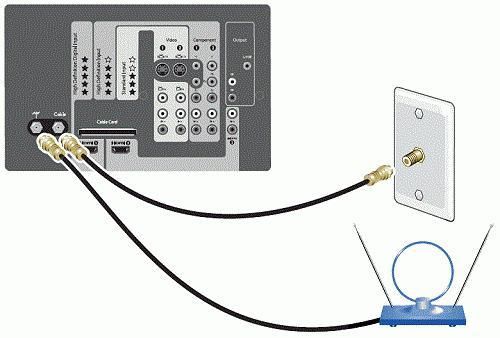
The procedure for connecting the beam structure
The beam antenna is connected in the same way as a room antenna, with the only difference being that its position is adjusted outside the room, often on the roof. Therefore, it is convenient to carry out this operation with a partner, communicating, for example, by mobile phone. The friend will inform the tuner about changes in picture quality depending on the results of his manipulations with the antenna.
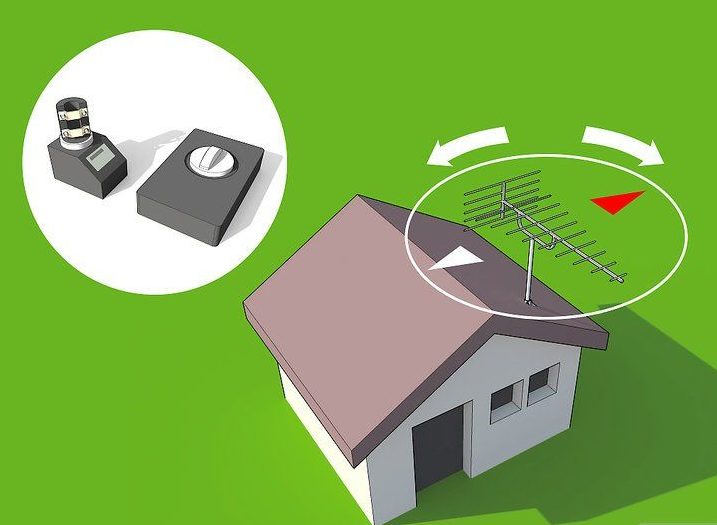
Array Antenna Connection
A massive antenna is the same beam antenna, often of large size and with an amplifier (active antenna). In this case, you will have to connect a power supply to the cable. The power supply has a special clamp where the coaxial cable from the antenna is attached.
Power to the amplifier goes through the metal braid of the cable, so it must be carefully cut, and after stripping it, put the braid back and insert the central core into the latch. The braid is then pressed together with the cable and clamp onto the tinned area. The indicator light should light up at full strength; if this is not the case, it means that the contact is incomplete or absent, you need to repeat everything again.

